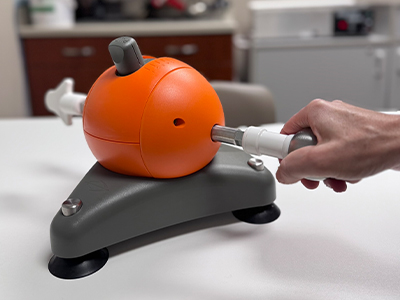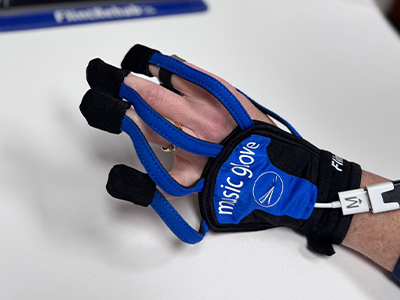Sandra “Sam” Scott — known to many in Jamestown as “Turbo” is the definition of determination. A North Dakota native, Sam is driven, hard-working and independent. She’s also a person living with quadriplegia, a form of paralysis affecting all four limbs — or, as she calls herself, “a walking quad.” Thanks to the Jamestown Regional Medical Center (JRMC) Occupational Therapy (OT) team, Sam has regained strength, mobility and confidence in her daily life.
Nearly forty years ago, Sam was in a car accident that left her with a broken neck and complete paralysis. Today, she walks with carbon-fiber leg braces and has partial mobility in both arms and legs. Her right side experiences significant sensory loss and weakness, while her left side is more affected by motor loss.

Earlier in 2025, Sam began noticing that her left hand was dropping things more frequently and struggling more with fine motor control. Her neurology provider in Fargo, Sarah Matcha, NP, referred her to JRMC Rehabilitation, where she began hand therapy with occupational therapist Leann Ripplinger in June.
“I have done OT before, but it always felt boring,” said Sam. “It was never that way at JRMC. With Leann, it always felt creative, fun and motivating!”
When Sam started therapy, her goals were simple but life-changing: regain the strength and coordination in her left hand to do daily tasks like tying her shoes or carrying things at work, even gaming on her PC without issue. After decades of limited motion, she was not sure what to expect — but was determined to try.
“Leann thinks outside the box — changed the plans when I plateaued and really personalized the treatment to what I needed,” recalled Sam. “I was really excited about all of the new technology and tools we got to use.”

To start, Leann created custom splints to help Sam stretch tight muscles and allow her to move her fingers more easily and comfortably throughout the day. Over the next three months of therapy, Sam used both innovative and classic therapy tools to build strength and dexterity, including:
- blood flow restriction cuffs to promote muscle growth and strength
- a SaeboGlove to help open her fingers and practice daily functional tasks
- electrical stimulation of weak and minimally responsive muscles
- Music Glove, a device which uses rhythm/touch sequencing to improve finger dexterity
- FEPsim (Flexion, Extension, Pronation and Supination) device, that arrived on her final day of therapy, to allow Sam to practice very functional daily tasks like opening a jar, using a key or turning a doorknob
After just a few months, Sam was amazed by the progress she had made after decades of lost motion.
“Forty years post-injury, I regained function in my left hand,” states Sam. “I’m dropping fewer things, tying my shoes, carrying items at work and able to use both of my hands again. It has really improved my attitude and helped me do more, at work and at home.”
With encouragement from the JRMC Rehab team and measurable results to celebrate, Sam’s perspective on OT — and even of her own abilities — has completely changed.
“This restoration in my hand has given me confidence and independence,” Sam said. “I feel less ‘disabled’ in the way that I present myself. When you feel capable and see that it’s possible, you’re willing to try, which is how you improve.”
As she reflects on her experience, Sam encourages others to take that same first step.
“Make the appointment and keep an open mind. This isn’t the ‘old’ OT,” she said. “If you try, do your exercises at home and follow instructions, you’ll be surprised by the results.”


